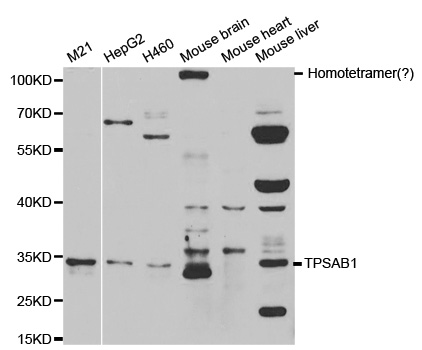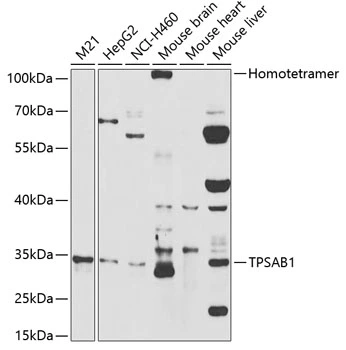Mast cell tryptase antibody [ZM96]
GTX01844
ApplicationsImmunoHistoChemistry, ImmunoHistoChemistry Paraffin
Product group Antibodies
ReactivityHuman
TargetTPSAB1
Overview
- SupplierGeneTex
- Product NameMast cell tryptase antibody [ZM96]
- Delivery Days Customer9
- Application Supplier NoteIHC-P: 1:100-1:200. *Optimal dilutions/concentrations should be determined by the researcher.Not tested in other applications.
- ApplicationsImmunoHistoChemistry, ImmunoHistoChemistry Paraffin
- CertificationResearch Use Only
- ClonalityMonoclonal
- Clone IDZM96
- ConjugateUnconjugated
- Gene ID7177
- Target nameTPSAB1
- Target descriptiontryptase alpha/beta 1
- Target synonymsTPS1, TPS2, TPSB1, TPSB2, Tryptase-2, tryptase alpha/beta-1, Tryptase II, Tryptase beta-2, epididymis secretory sperm binding protein, mast cell alpha II tryptase, mast cell beta I tryptase, mast cell tryptase, tryptase alpha II, tryptase alpha-1, tryptase beta I, tryptase beta-1, tryptase-1, tryptase-I, tryptase-III
- HostMouse
- IsotypeIgG1
- Protein IDP20231
- Protein NameTryptase beta-2
- Scientific DescriptionTryptases comprise a family of trypsin-like serine proteases, the peptidase family S1. Tryptases are enzymatically active only as heparin-stabilized tetramers, and they are resistant to all known endogenous proteinase inhibitors. Several tryptase genes are clustered on chromosome 16p13.3. These genes are characterized by several distinct features. They have a highly conserved 3 UTR and contain tandem repeat sequences at the 5 flank and 3 UTR which are thought to play a role in regulation of the mRNA stability. These genes have an intron immediately upstream of the initiator Met codon, which separates the site of transcription initiation from protein coding sequence. This feature is characteristic of tryptases but is unusual in other genes. The alleles of this gene exhibit an unusual amount of sequence variation, such that the alleles were once thought to represent two separate genes, alpha and beta 1. Beta tryptases appear to be the main isoenzymes expressed in mast cells; whereas in basophils, alpha tryptases predominate. Tryptases have been implicated as mediators in the pathogenesis of asthma and other allergic and inflammatory disorders. [provided by RefSeq, Jul 2008]
- ReactivityHuman
- Storage Instruction2°C to 8°C
- UNSPSC12352203




![IHC-P analysis of human tonsil tissue using GTX17823 Mast cell tryptase antibody [TPSAB1/1961].](https://www.genetex.com/upload/website/prouct_img/normal/GTX17823/GTX17823_20200115_IHC-P_1415_w_23060620_578.webp)
![IHC-P analysis of human tonsil tissue using GTX22378 Mast cell tryptase antibody [AA1].](https://www.genetex.com/upload/website/prouct_img/normal/GTX22378/GTX22378_20191203_IHC-P_98_w_23060620_641.webp)
